Welcome back, Premier League! The top flight of English football finally returns after a six-week break. The first matchday brought together multiple UEFA Champions League winners as well as former Real Madrid managers in José Mourinho and Carlo Ancelotti. Both managers were looking for a win after failing to close the 2019/20 season with three points.
The game was more like a game of chess. From time to time, Mourinho and Ancelotti adjusted their tactics to cancel out their counterpart’s strategies. For the naked eyes, the match seemed a bit dull because of that. However, there’s a lot more to it tactically than meets the eye. Without further ado, this tactical analysis will examine how Everton were able to defeat Tottenham Hotspur away from home.
Lineups
Mourinho opted for 4–2–3–1 in this game. The back-four consisted of Ben Davies, Eric Dier, Toby Alderweireld, as well as new recruit Matt Doherty. Upfront, talisman Harry Kane was supported by the trio of Lucas Moura, Dele Alli, and Son Heung-min just behind him. Spurs’ dugout was filled with names like Moussa Sissoko, Steven Bergwijn, and Tanguy Ndombélé.
In the opposite side, Ancelotti chose 4–1–4–1 for his team. All of their blockbuster signings — Allan, Abdoulaye Doucouré, and James Rodríguez — were chosen to start the game. The former two played in the midfield alongside ex-Barcelona player André Gomes, while the latter started in the attacking line alongside Dominic Calvert-Lewin and Richarlison. Players like Gylfi Sigurðsson, Tom Davies, and Moise Kean had to start the match from the bench.
Conservative start from the Lilywhites
This analysis will start by examining Tottenham’s cautious defensive tactics in the opening sequence of the game. Spurs did that by defending in a mid-block 4–4–2 whenever the Toffees enjoy the possession. Sometimes, they could even be found defending deeper with more compactness in the structure.
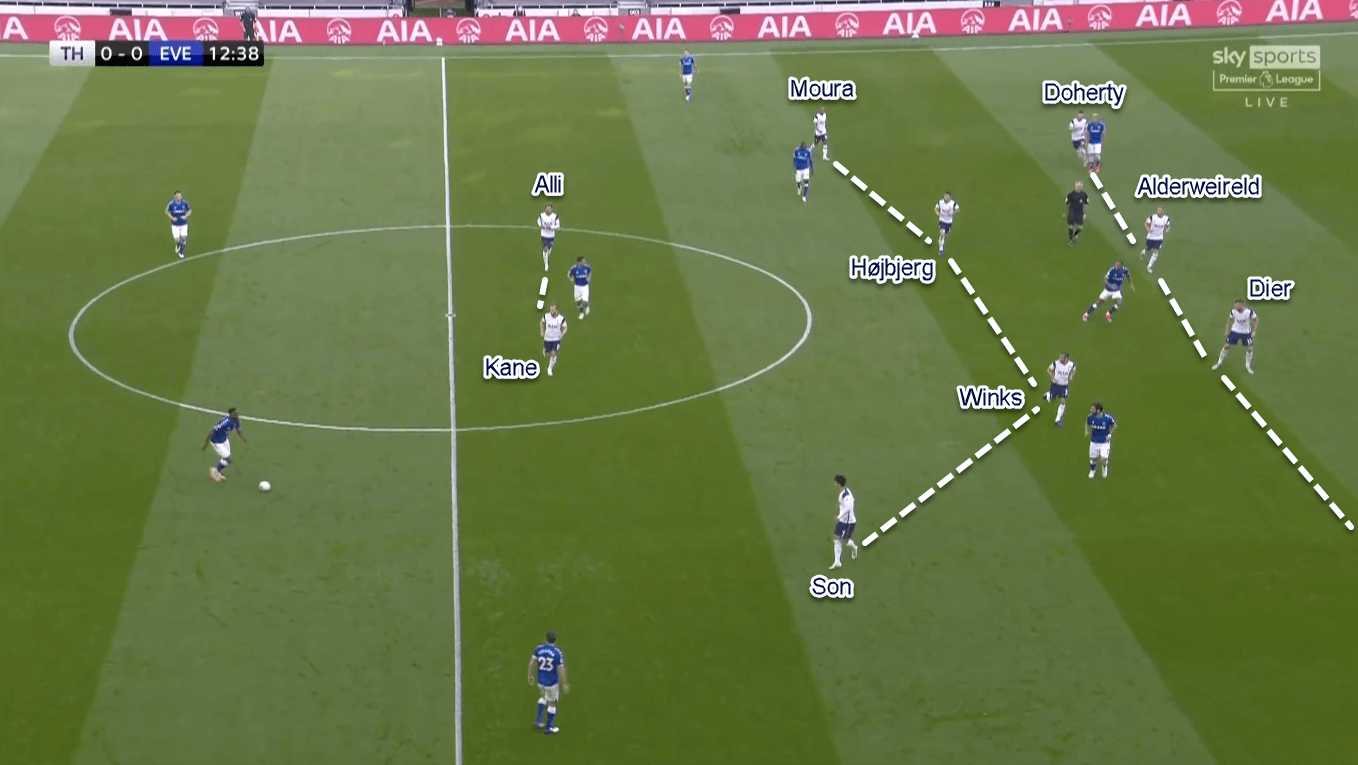
Everton — given the chance to have the ball — moved to a 2–3–5-ish shape in their attacks. In that shape, both full-backs went wide alongside the attackers, while the wingers tucked inside to play in the half-spaces. Behind them, Doucouré, Allan, and Gomes stayed in a rather flat line in the midfield; providing balance for the marauding full-backs.
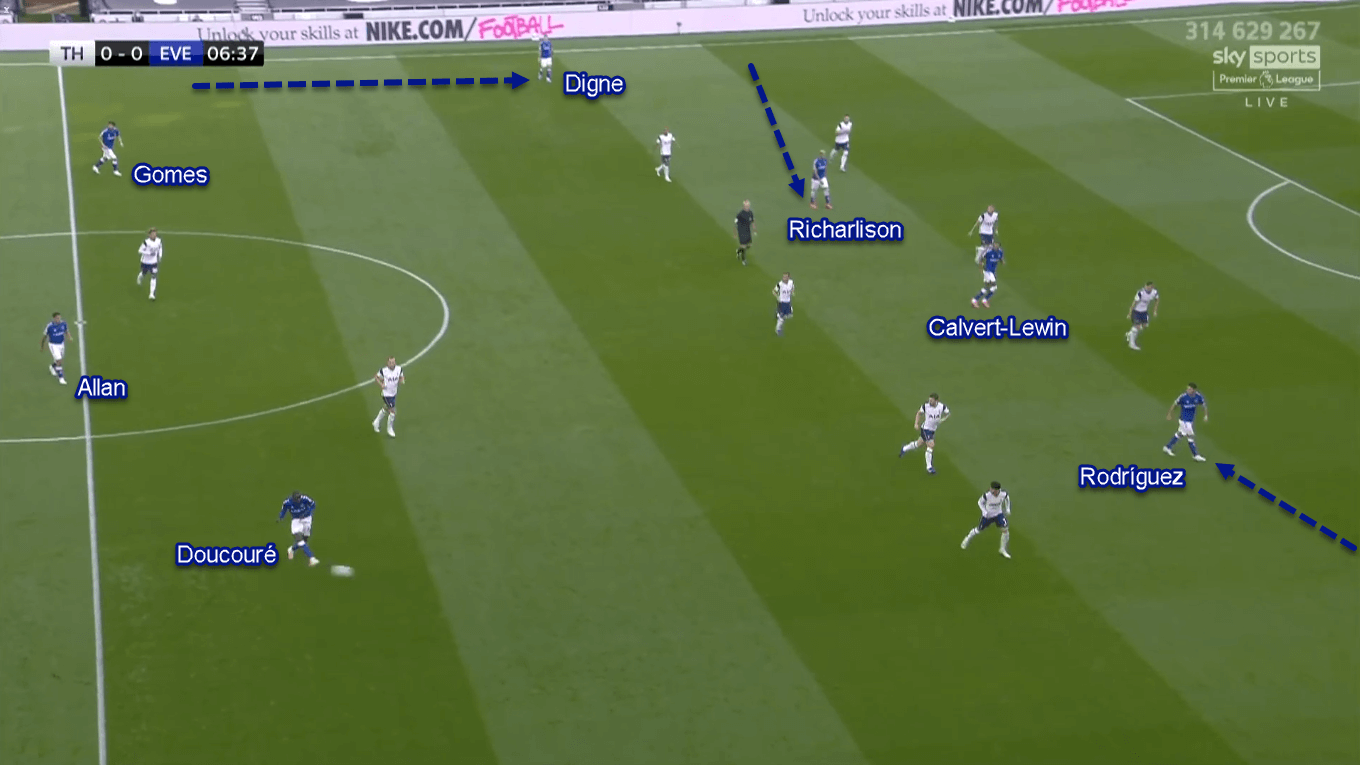
Despite the ‘conservative’ shape, Spurs defended quite actively when Everton tried to penetrate their block. That being their activeness to set up traps and cover the spaces cleverly whenever Everton tried to move through the thirds. There are differences, though, especially when the ball was played centrally and through the flanks.
Spurs’ active defending
If Everton tried to build their attacks centrally, the centre-backs would usually try to find one of the midfielders in between Spurs’ forward and midfield lines. Mourinho reacted to that by allowing either Pierre-Emile Højbjerg or Harry Winks to step up from their position and close the receiving opponent in between the lines. By doing so, Højbjerg or Winks would prevent the midfielder to receive comfortably and disable him to progress the ball. As a result, Everton were forced to play negatively at times.
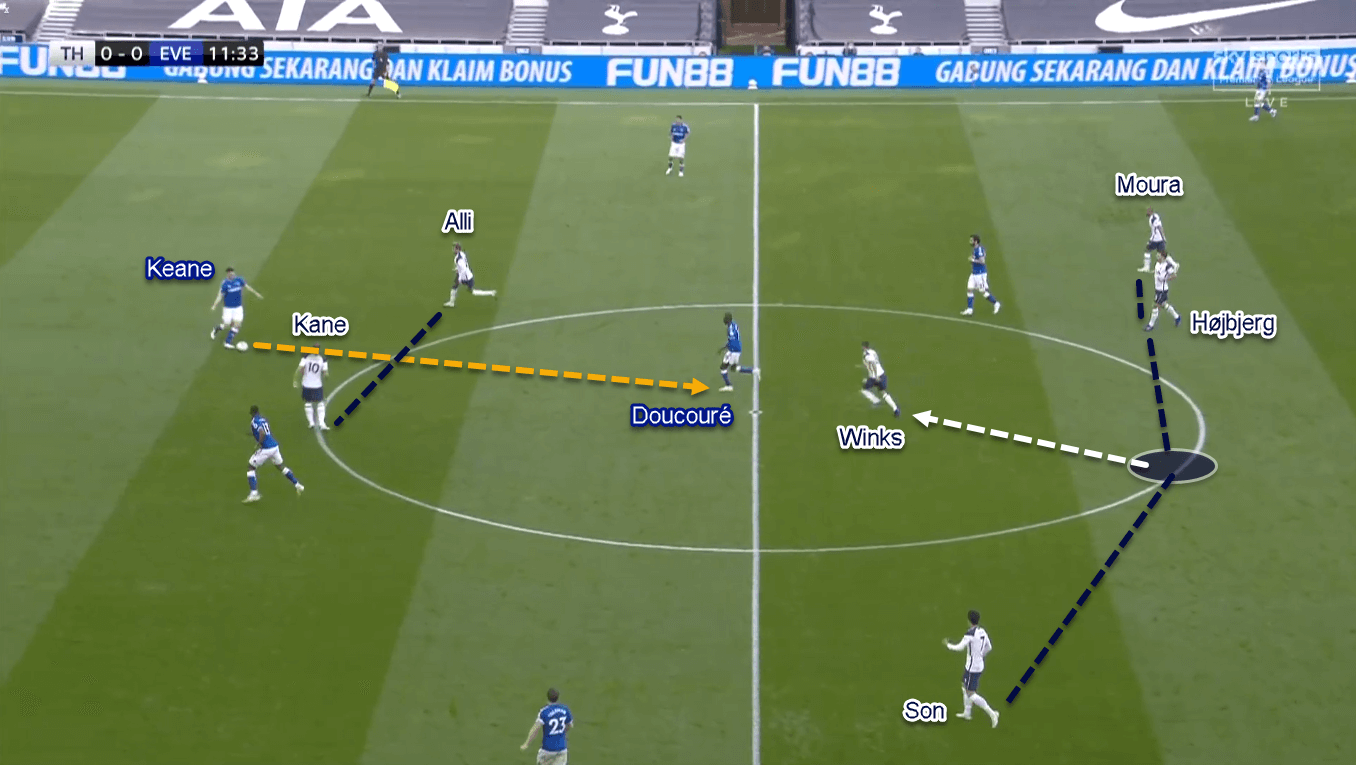
A different setup could be found when the visitors tried to build from wide areas. Usually, Mourinho would ask his full-back to step up from the backline and close Everton’s full-back on the flank. That means when Coleman had the ball in the right-wing, B. Davies would leave Dier and close the Irishman. Meanwhile, whenever Digne was trying to penetrate in the opposite flank, Doherty was the one given the task to press.
The aggressive movement by Spurs’ full-back practically would open a gap in the defensive line. This gap could be attacked by Everton’s inside forward by sprinting in behind. However, Mourinho cleverly closed the gap by utilising his ball-side defensive midfielder to drop from his position and follow the darting opponents’ attacker. By doing so, the midfielder could cover the space left by his full-back partner as well as preventing Everton from attacking in behind Spurs’ backline.
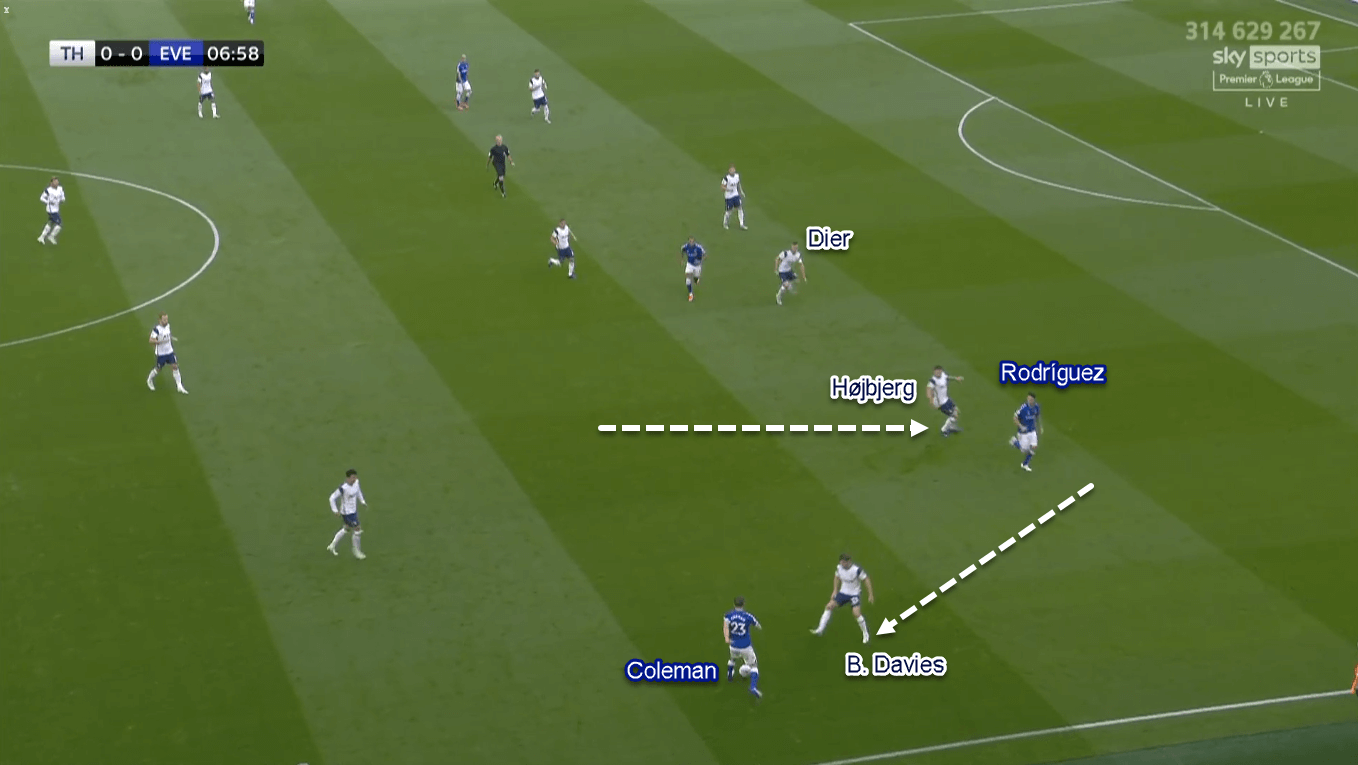
Early adjustments
Everton’s advanced full-backs and Spurs’ active defending sometimes allowed the home side to get counter-attacking opportunities. Some numbers that backed this. Spurs — who enjoyed only 34% of the ball in the opening 15 minutes — actually managed to get 0.6 attacks per minute. For comparison, Everton only averaged 0.4 attacks per minute on the same timeframe.
Spurs’ threat in transition forced Ancelotti to react. The Italian manager then pulled the full-backs and shifted his team’s attacking structure to a 4–3–3/4–1–2–3-ish shape. This adjustment provided more defensive solidity for Everton at the expense of somewhat reduced threats in the opposite end.
Mourinho responded to this by instructing his men to defend with more aggression. First of all, he tasked Moura and Son to step up from the midfield line to press Everton’s on-ball full-back. This would usually prevent the full-back to progress the ball to the midfielders; even forcing them to play negatively at times.
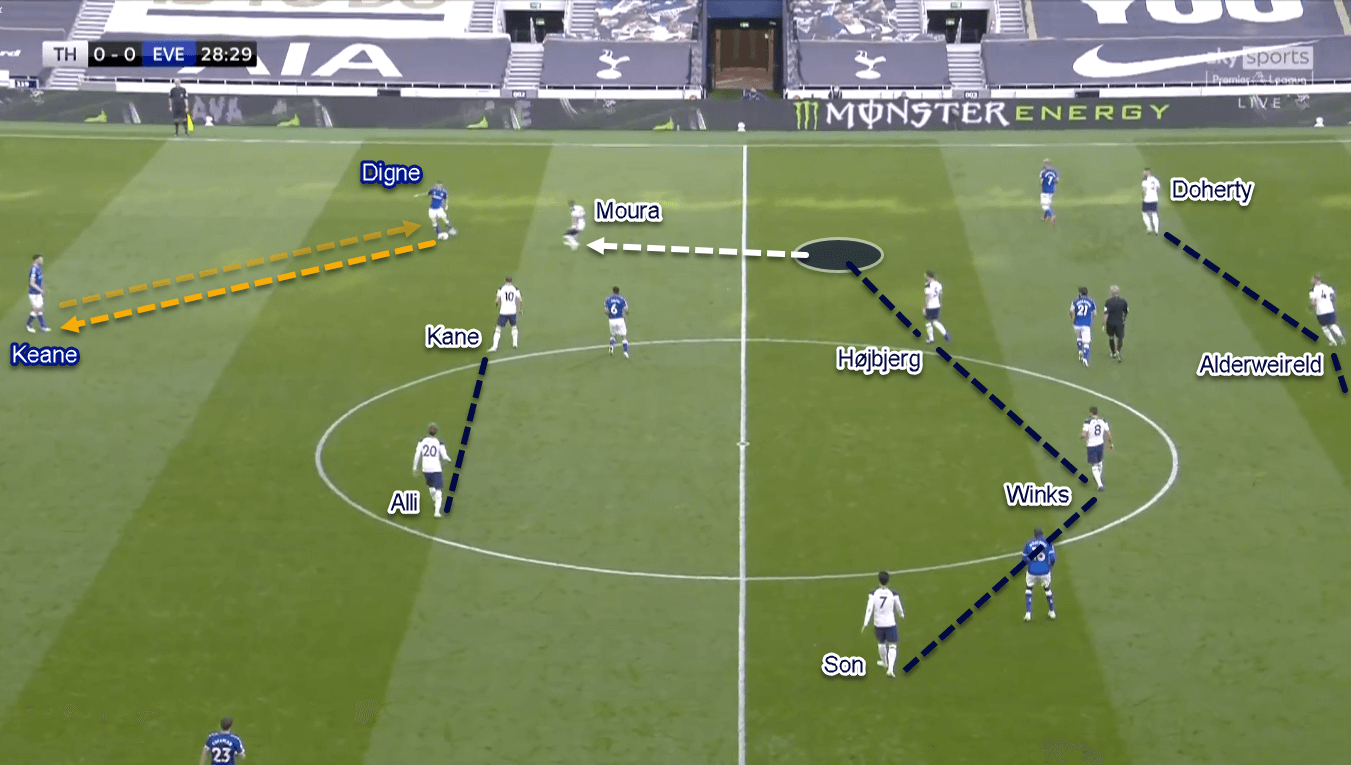
It’s not just that, though. Knowing Everton have fewer players upfront, Spurs moved their defensive block forward and now press in a medium-high 4–1–3–2. In the first line of pressure, two Spurs attackers would press Everton’s centre-backs (and the goalkeeper).
Behind them, one defensive midfielder would step up and leave his partner to join Spurs’ second line of pressure. This three-man line was important to prevent Everton from accessing their full-backs and/or their central midfielders. As a result, the Toffees had to play ineffective long balls to Calvert-Lewin and co.
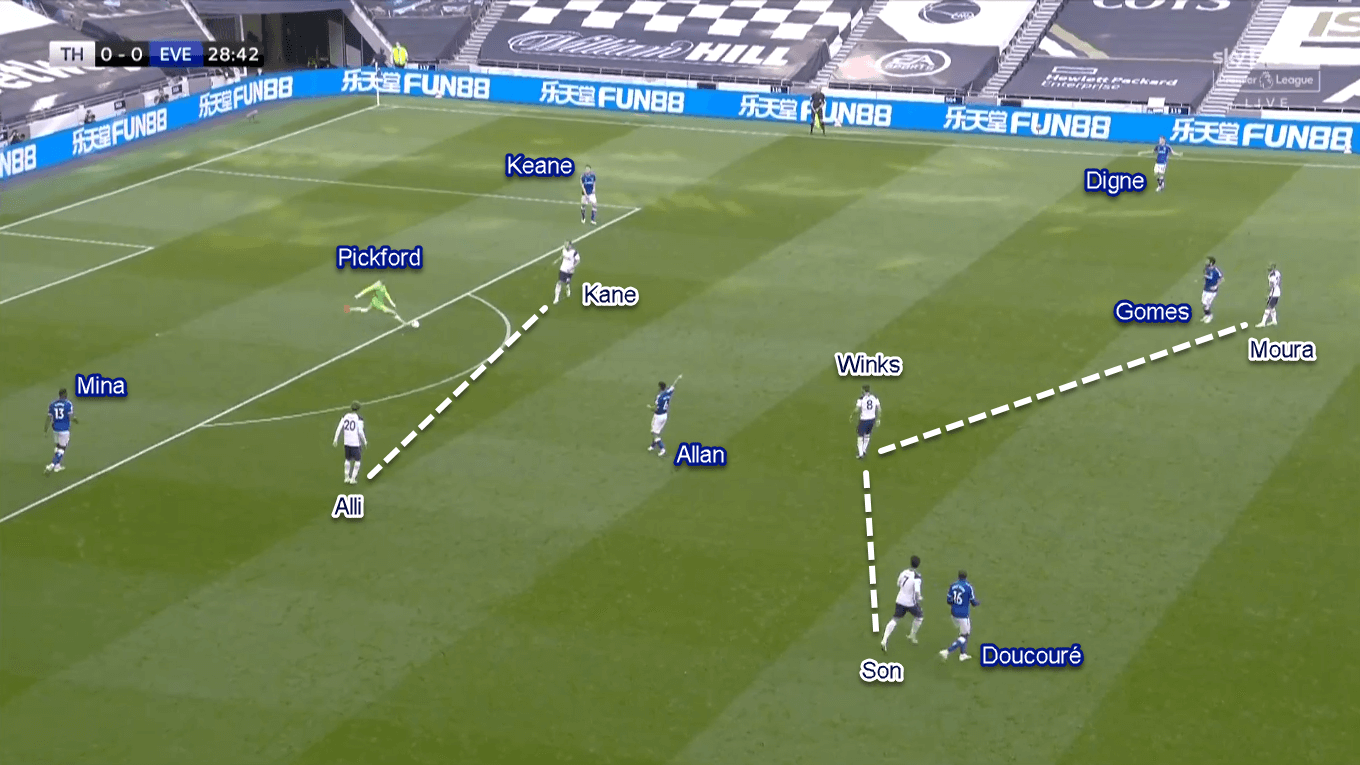
Spurs’ positional attacks
Mourinho’s men were the ones having the lion share of the ball in the last 30 minutes of the first half. When they had the ball, Spurs moved to a lopsided 3–2–4–1/3–2–5-ish shape with one interesting feature. That particular feature was the ‘floating’ position given to B. Davies.
There were three possibilities on where he could play in the lopsided structure. First, he could drop and join the centre-backs in Spurs’ first attacking line. Second, he could tuck inside and join the midfield line. However, when he did that, one of the midfielders (mainly Højbjerg) would drop and play as a temporary outside centre-back. Last but not least, he could bomb forward and provide the width in the left flank. When he did that, Son would move inside and play in the half-space instead.
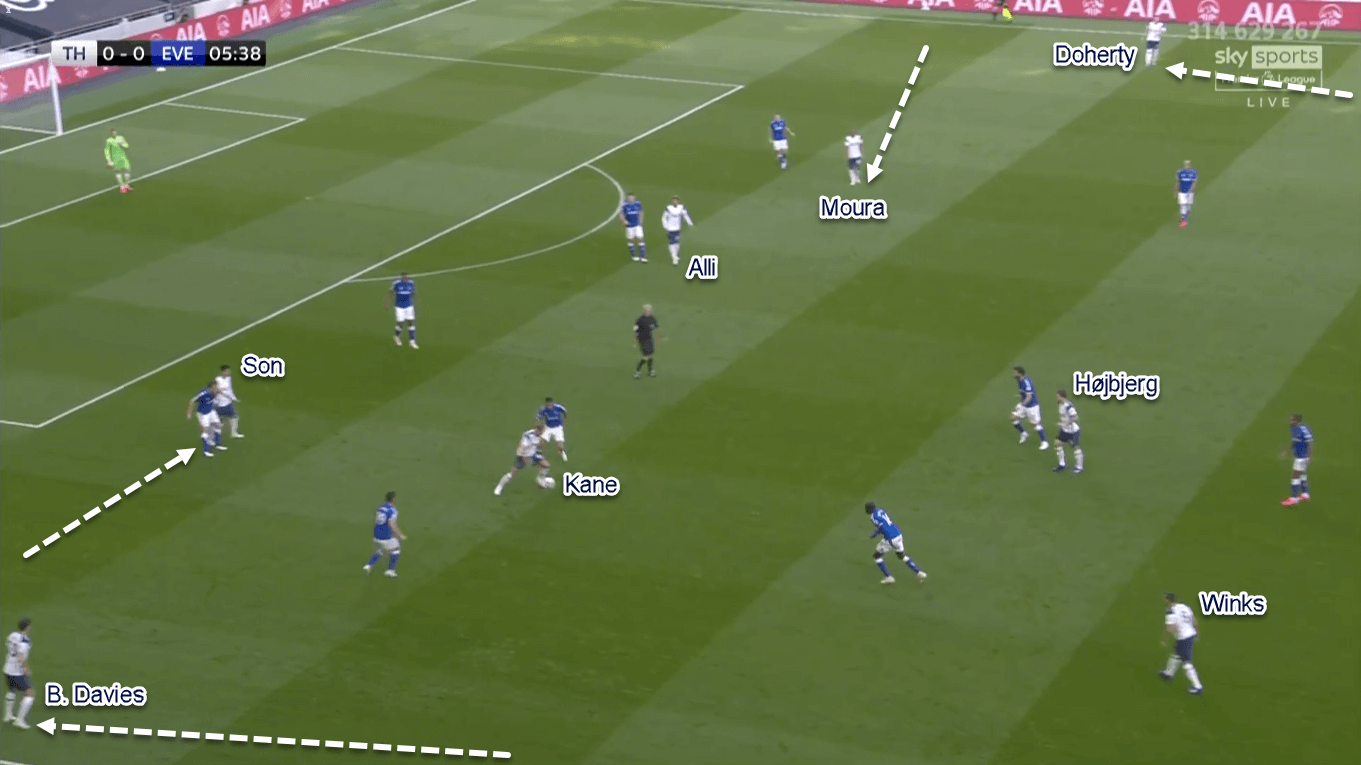
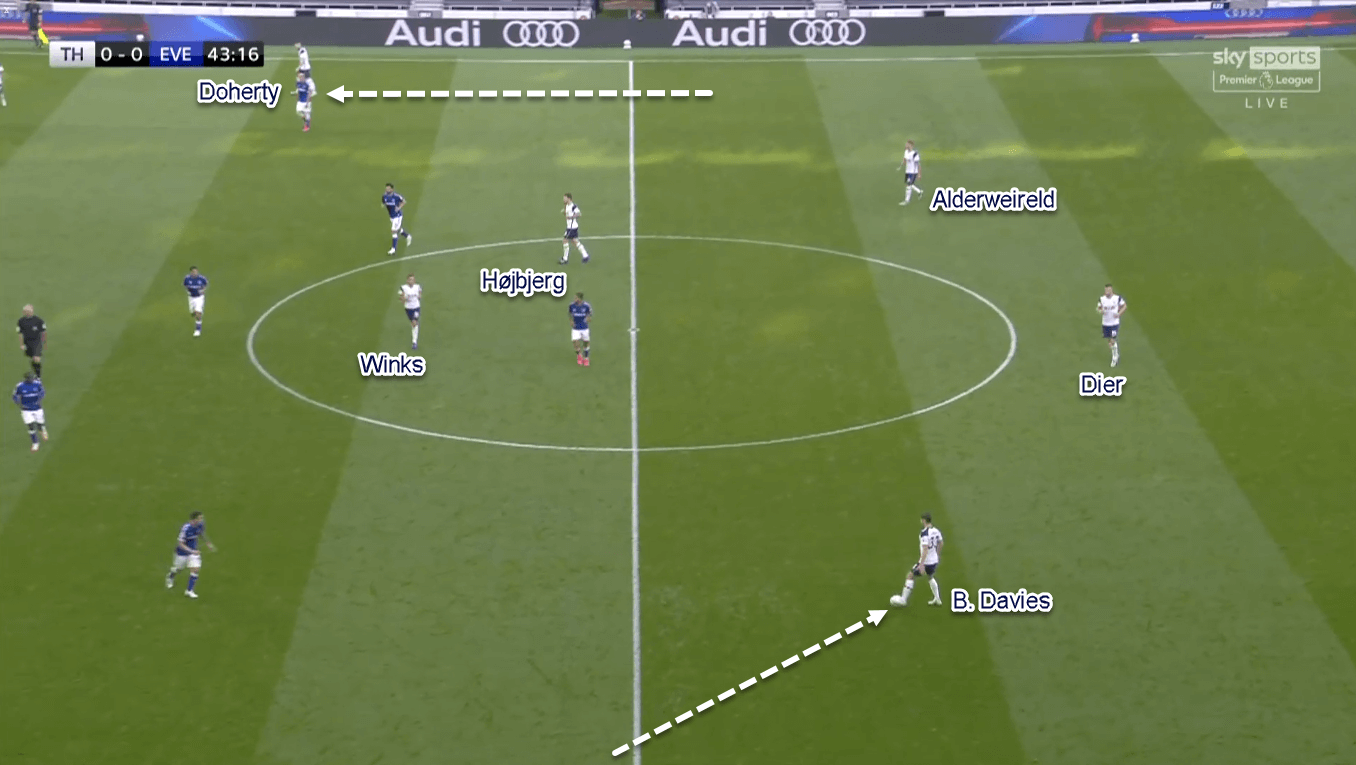
Meanwhile, there was a ‘less chaotic’ rotation in the opposite flank. That being Moura and Doherty’s unchanged behaviour compared to Davies and co. in the left-wing. To be more specific, Doherty was tasked to provide the width while Moura was instructed to play inside and in between the lines.
Whenever Spurs have the ball, they would try to access the area in between Everton’s lines. That’s because the Toffees would only have Allan covering that space, while Spurs could have up to three players there; a numerical advantage for the home side. To exploit that gap, Mourinho instructed the centre-backs to play grounded vertical passes directly to the advanced players and allow the attackers to combine after that.
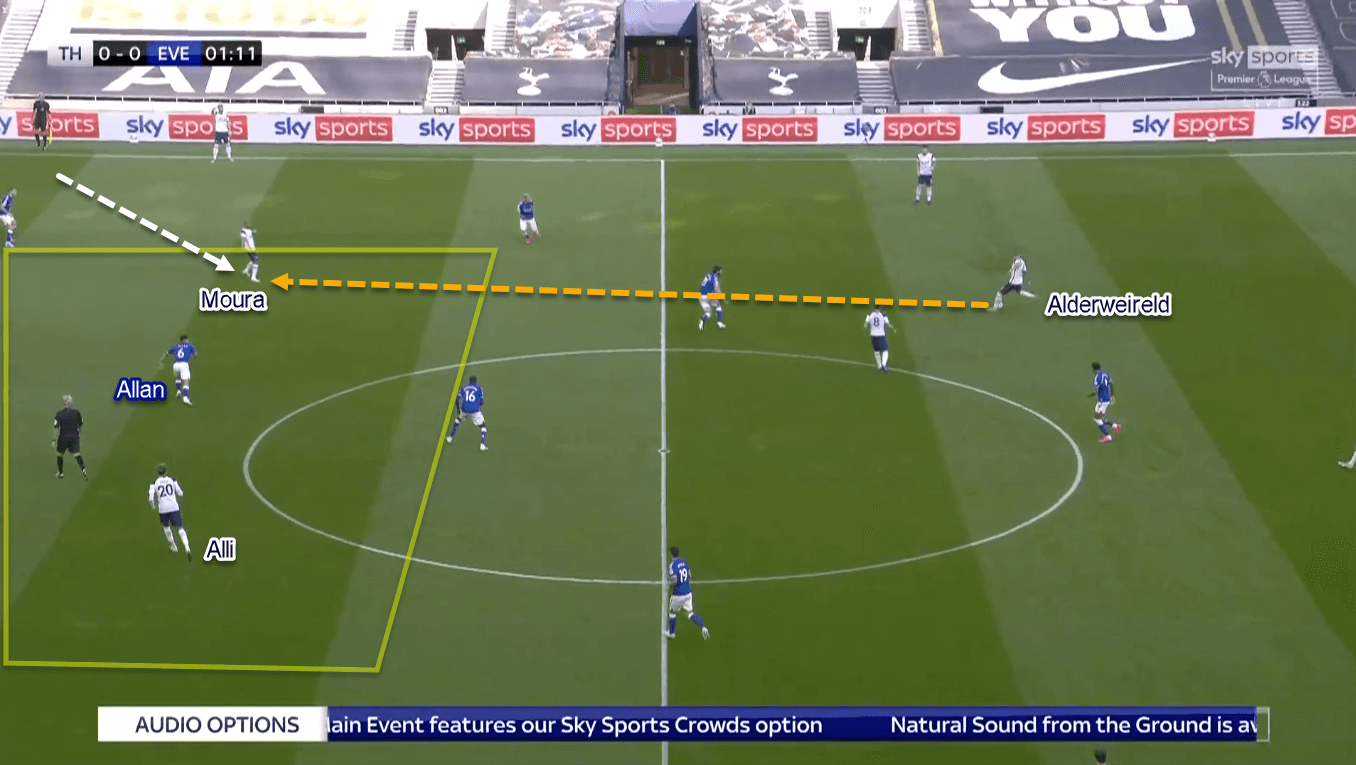
Everton with the ball-oriented press
The Blues answered Spurs’ possession game with a ball-oriented pressing system. Structure-wise, they kept the mid-block 4–1–4–1. However, they added more compactness later in the first half to prevent Spurs from accessing the area in between the lines.
Now, let’s dissect Everton’s ball-oriented pressing system. In this system, Everton started by defending zonally in their 4–1–4–1. However, one player usually would step up from his position to press the on-ball opponent in front of him, while his defensive partners stay within the designated line.
The pressure then would force the on-ball Spurs player to pass the ball to his teammate. When the ball is still on its way, another man in blue would step up to press even before the ball arrived on the targeted Spurs’ players. This press would limit the space and time for the opponent; which forced him to move the ball again with less comfort and stability. The objective of this pressing was to force Spurs to play sideways before attempting to steal the ball in the flank.
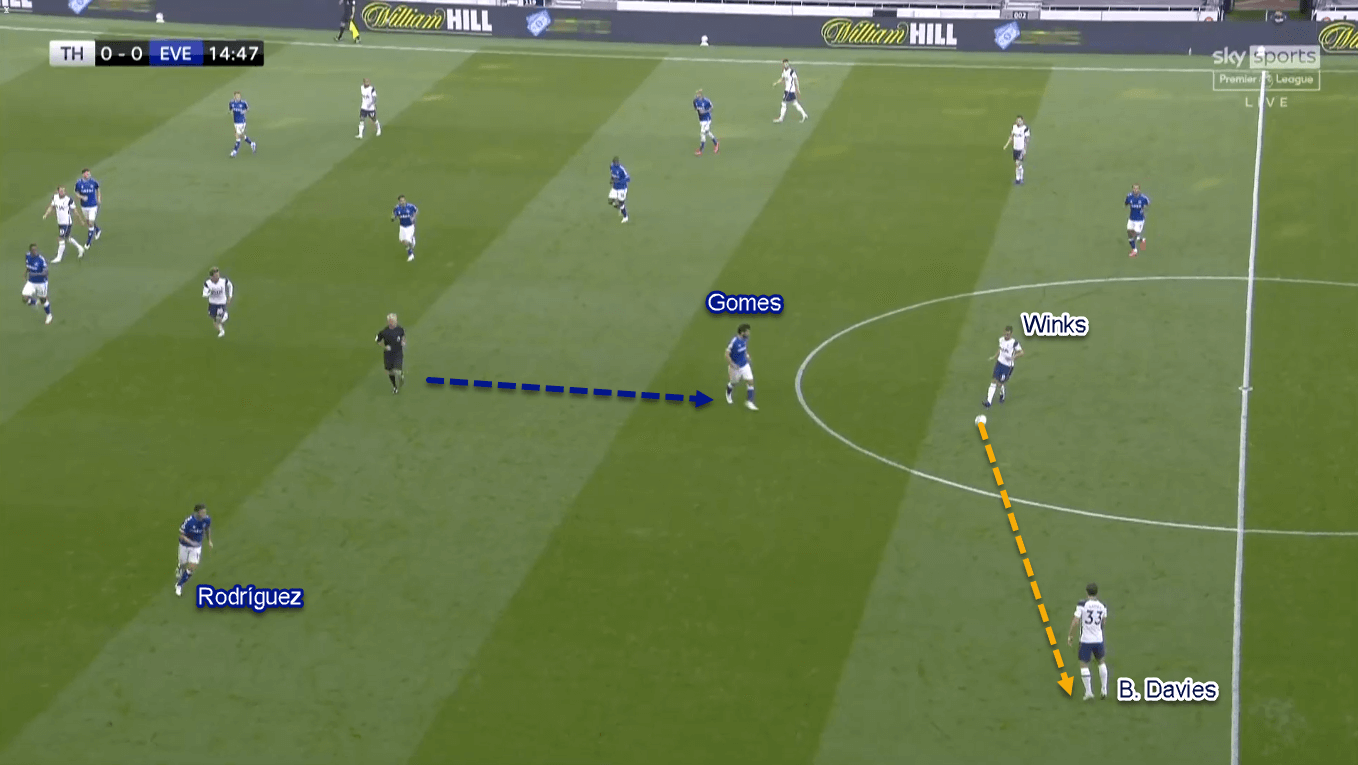
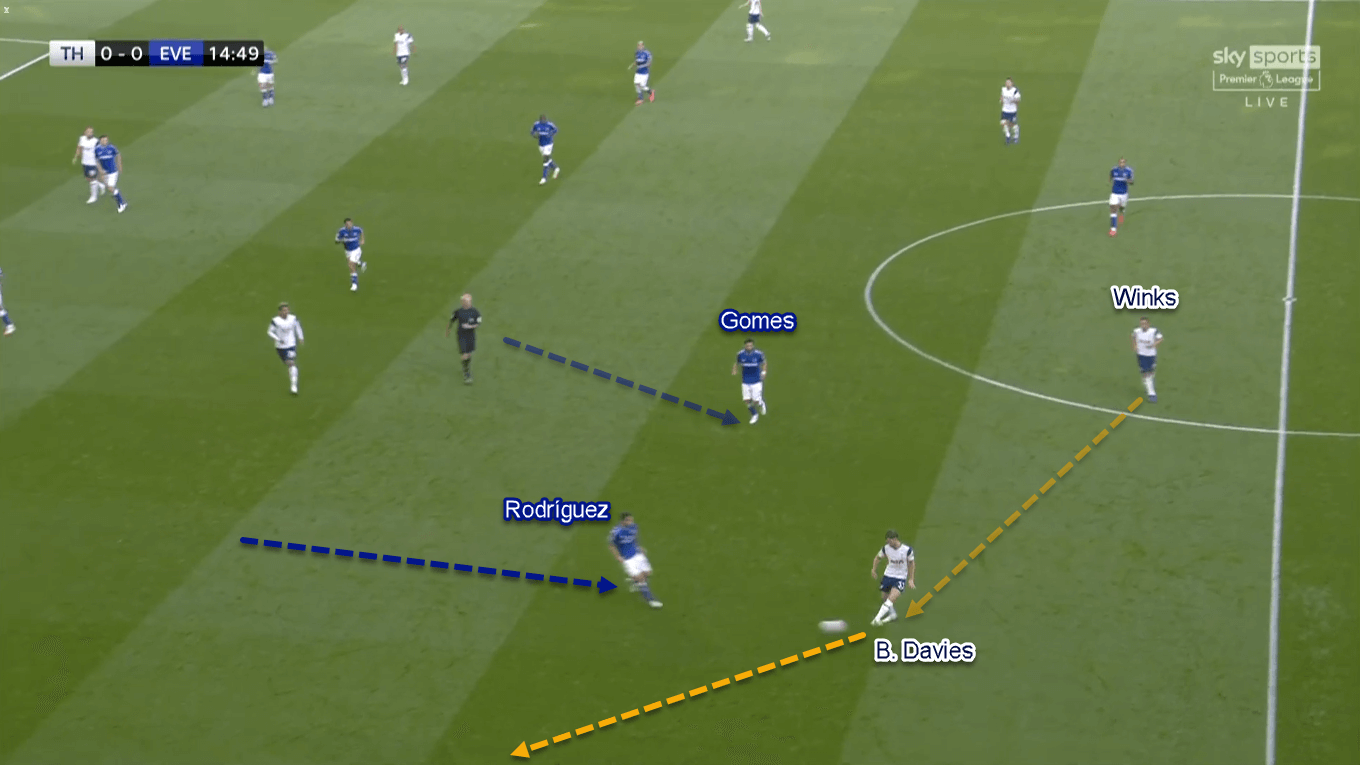
The name is Bond, James Rodríguez
Pardon the meme-inspired subheading. Everton usually didn’t spend a lot of time on possession. They would try to quickly find the advanced player in the next attacking line to progress the attack. The same could be said with Rodríguez in this game. Ancelotti would ask his deeper player(s) — mainly Allan — to quickly find the Colombian to continue the attack. The stats show that Allan finished the game with 15 (71.42%) accurate forward passes; most among his teammates.
Position-wise, Rodríguez played in the right half-space. However, he could also drop a bit to receive in between the lines. By doing so, Rodríguez was able to free himself from Spurs’ defenders because Calvert-Lewin has pinned the backline with his advanced positioning. If Rodríguez wasn’t allowed space in between the lines, he could even drop deeper to play in front of Spurs’ midfielders.
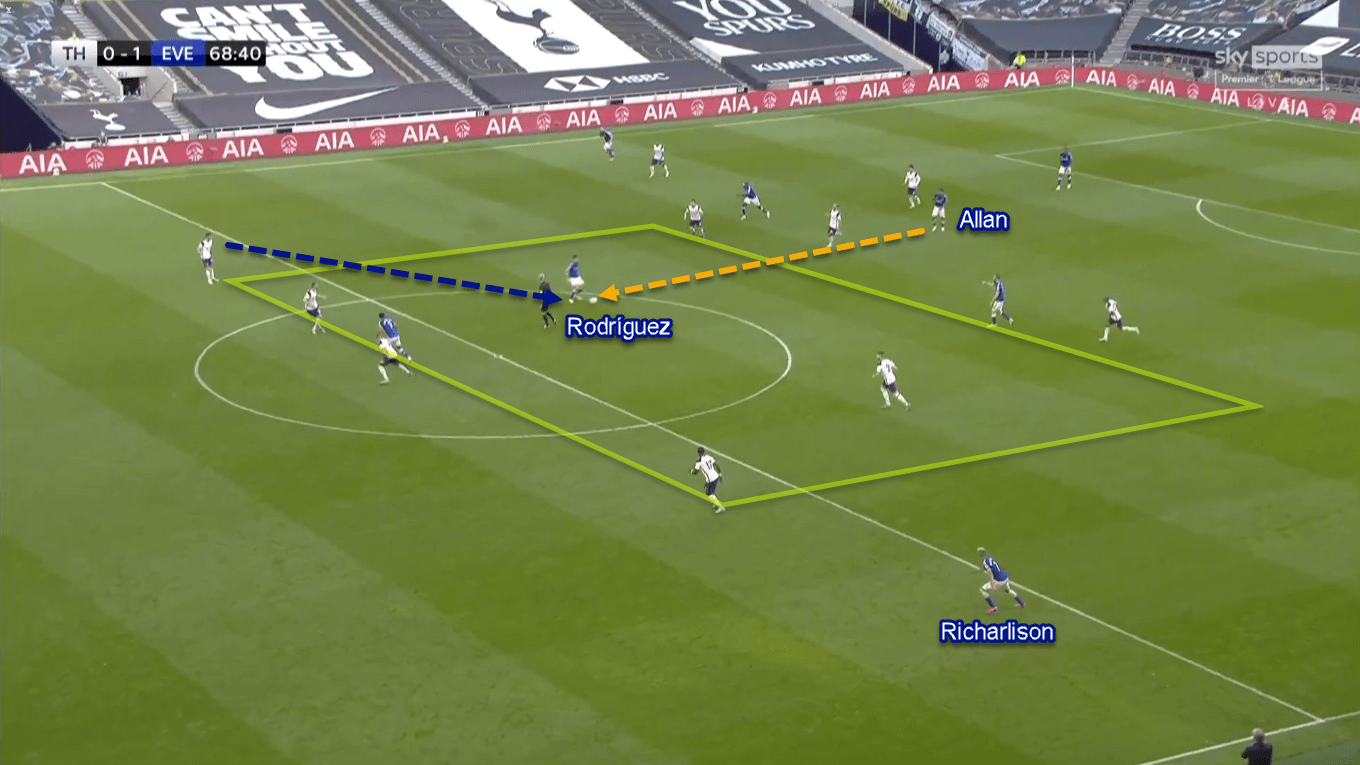
Whenever Rodríguez had the ball, he would try to send a diagonal pass to Richarlison or the overlapping Digne in the left flank. After that, the receiver would continue the attack with their own tendencies. Richarlison — the left-winger — would usually cut inside before making a shot from the half-space. Oppositely, Digne preferred to utilise his left-foot and send crosses into the box.
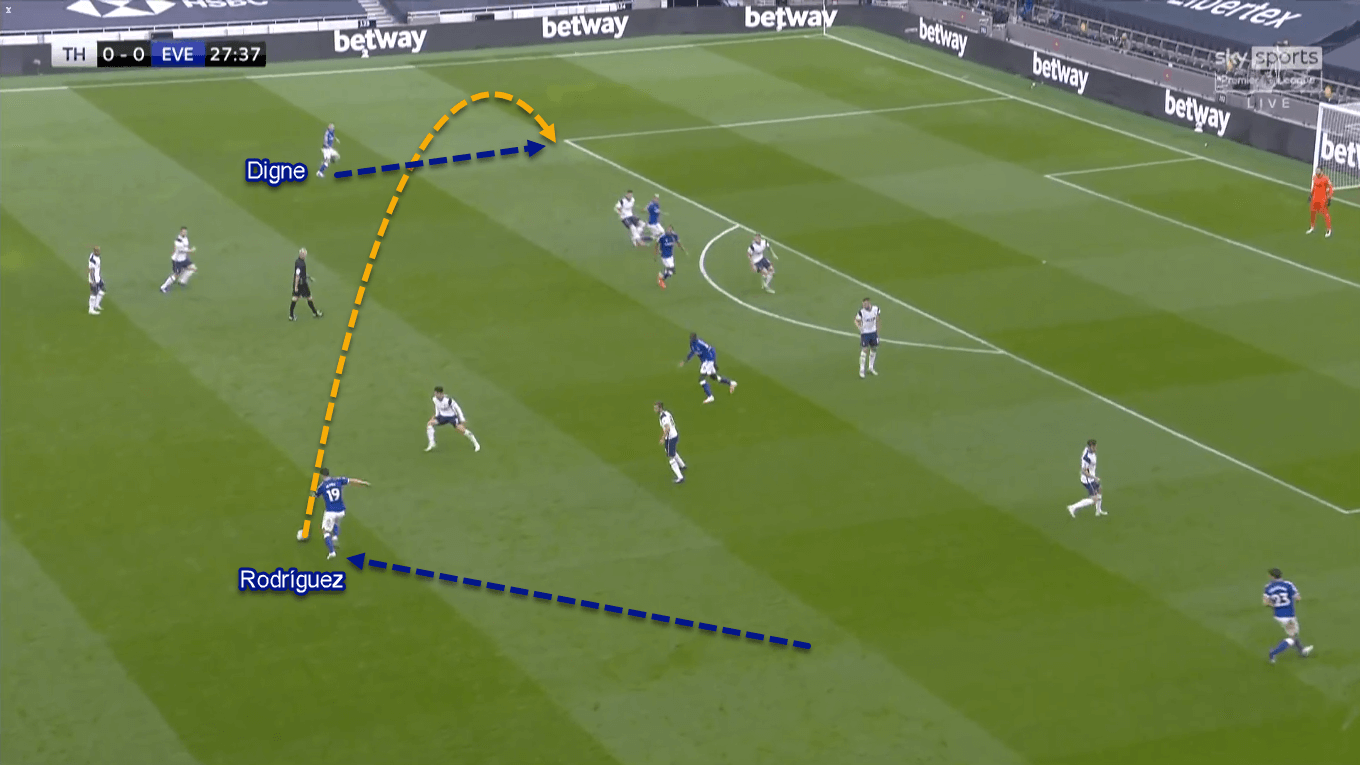
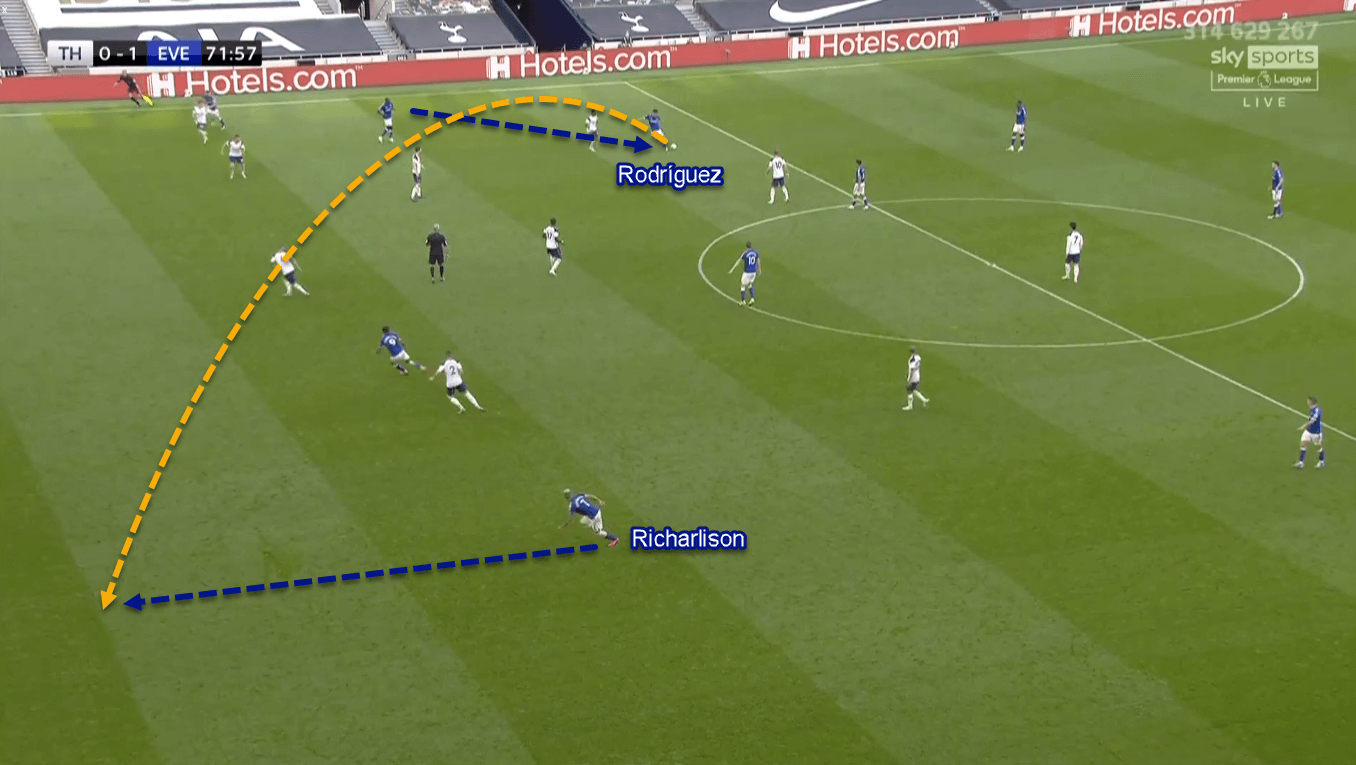
However, none of them was efficient in the final third. Richarlison only managed to get one (16.67%) on target from six shots. He’s even worse in terms of crossing, with zero accurate crosses from four attempts. Digne was not much better, though. The former Barcelona player was only able to find his teammate once (20%) from five crossing efforts.
Unfruitful second-half adjustments from the home side
Tottenham came into the second half with more aggression. They left their mid-block defending behind and moved to the medium-high 4–1–3–2. The objective of that structure stayed the same: to press Everton’s deeper players and force them to play ineffective long balls upfront.
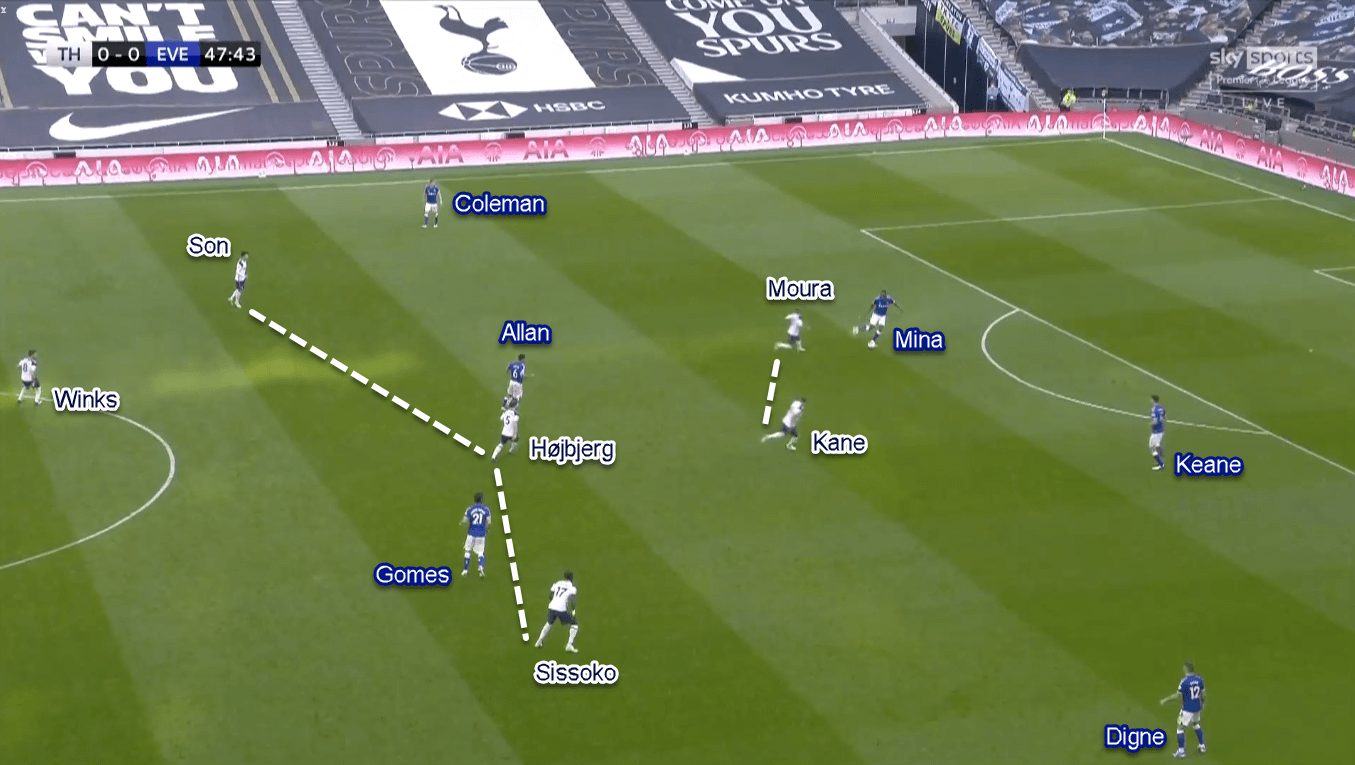
Tottenham shifted their defensive system in the last 20 minutes of the games. They moved to a medium-high 4–4–2 with the lone pivot joining the midfield trio in Spurs’ second line of pressure. It wasn’t just that, though. In the 4–4–2, Spurs tried to defend in a man-oriented manner. It means that each of their midfielders and attackers would try to engage in one-versus-one duels against Everton players and try to steal the ball more aggressively.
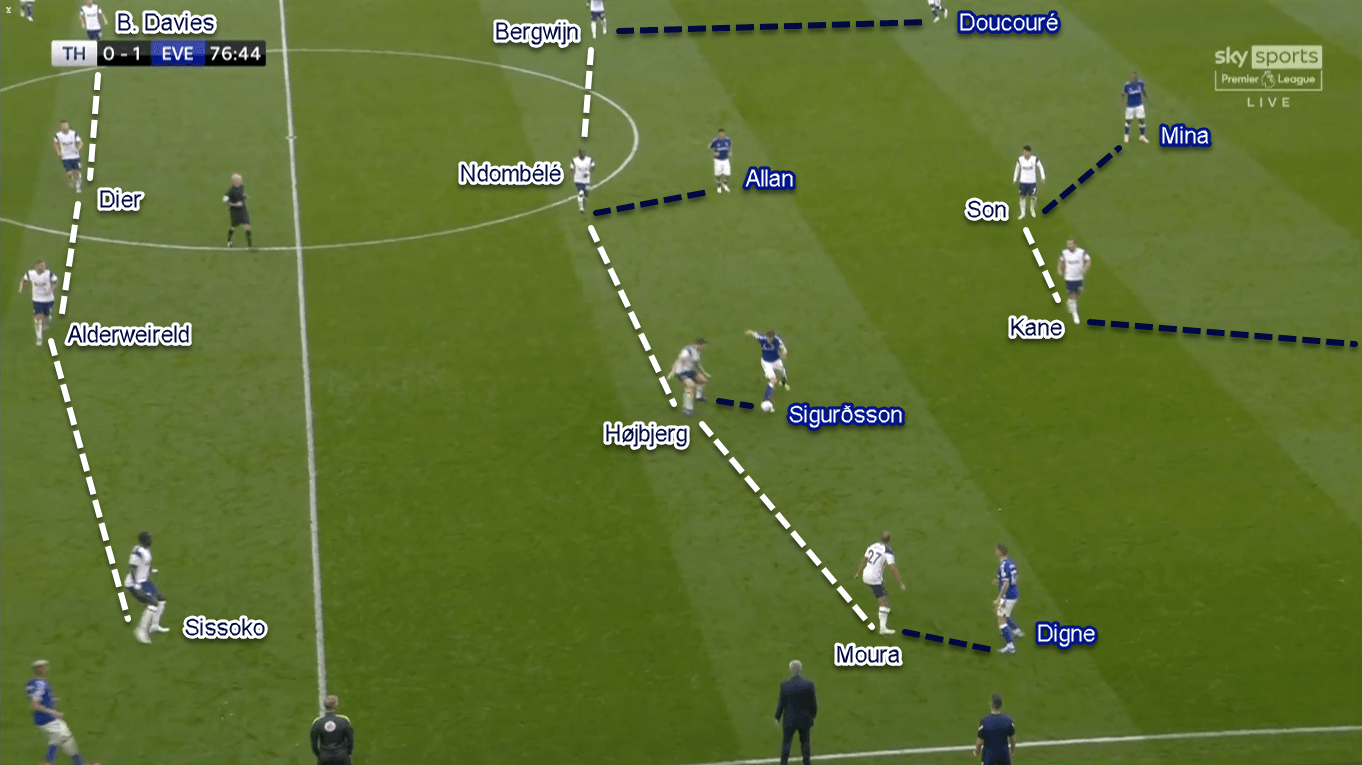
On the ball, Spurs were dictated by the visitors. Firstly, that happened because Everton moved to a more compact 4–1–4–1. This packed structure allowed Spurs almost no space in between the lines, thus forcing them to play through the flanks.
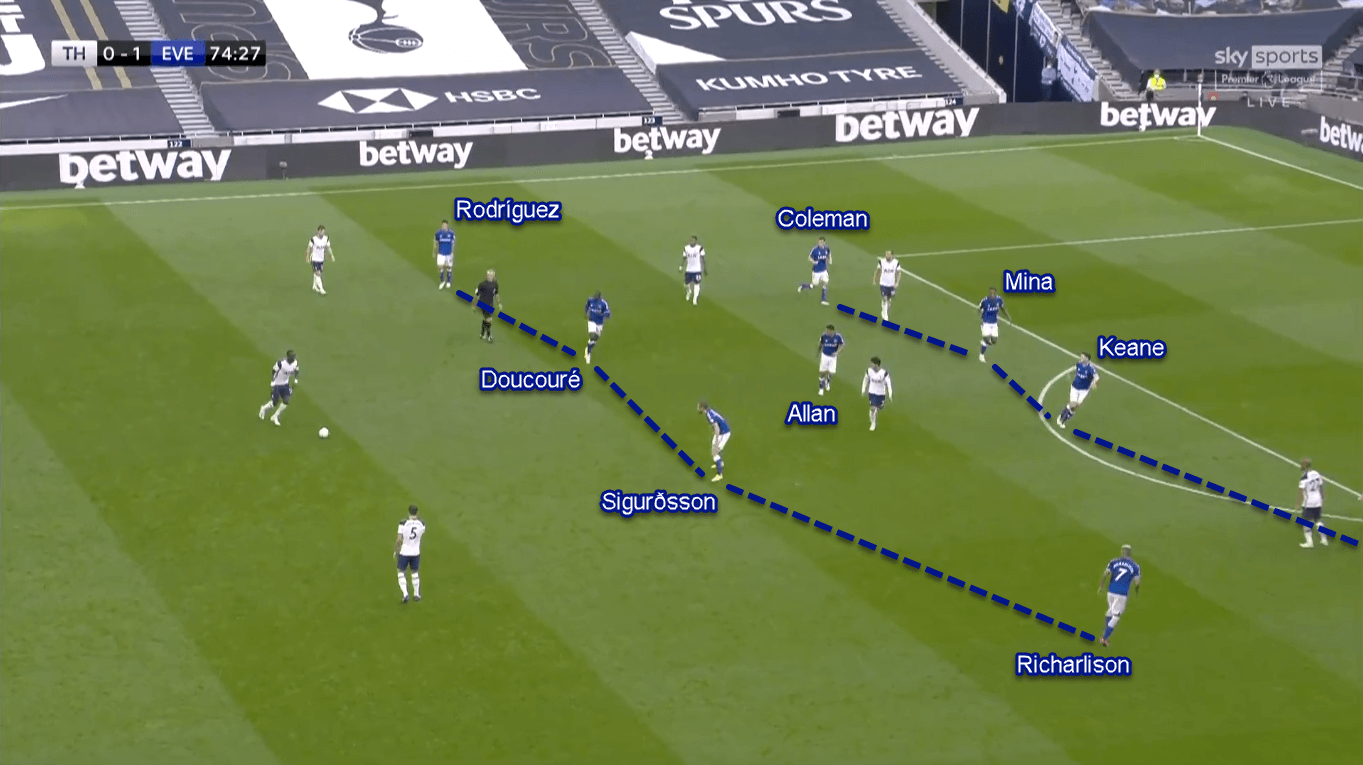
Unfortunate for the home side, Everton were able to contain Spurs’ threats when playing wide. That’s because they would flood the touchline area with up to four players and overload the men in white. Those include the ball-side full-back, winger, central midfielder, and the nearby centre-back/defensive midfielder. Even if Spurs could escape the flank press, their distribution quality let them down. If we look at the statistics, Tottenham only managed to make eight (36.36%) successful crosses throughout the game.
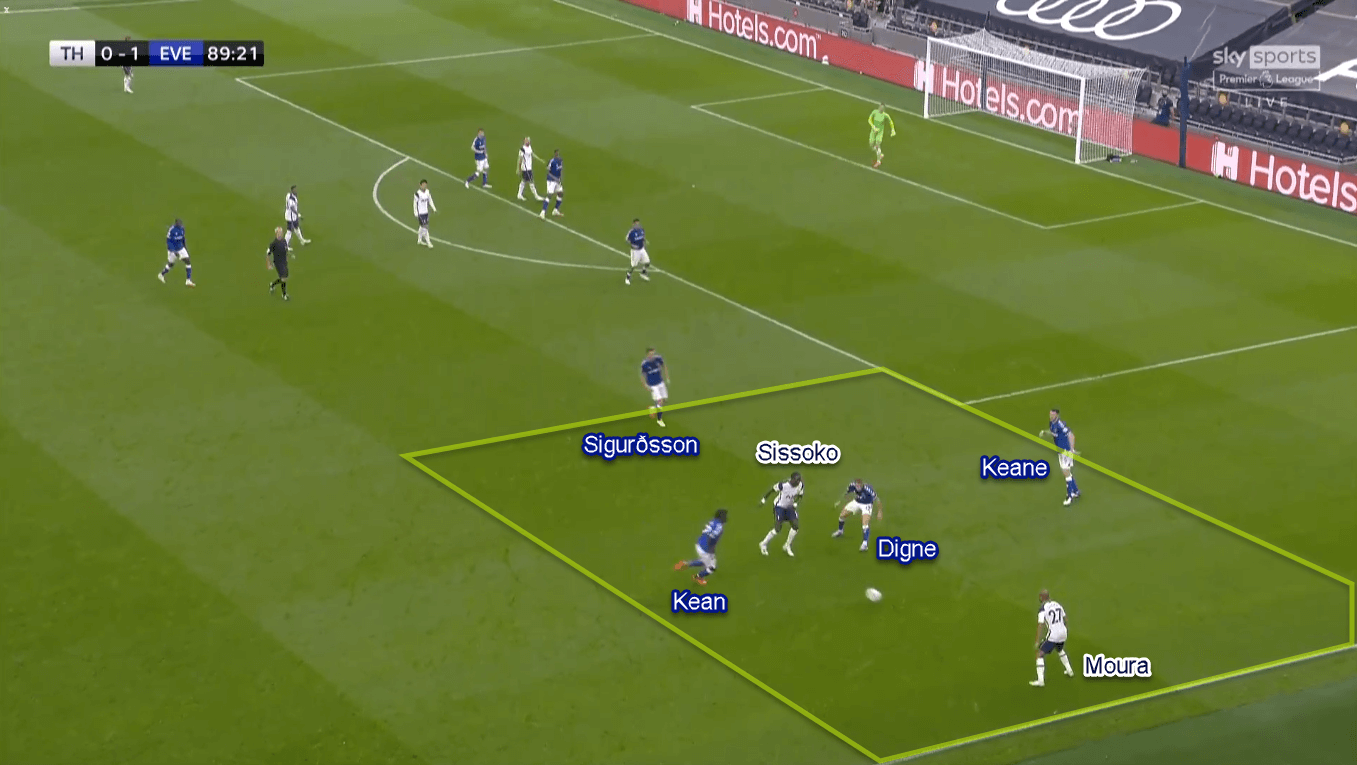
Clever (yet controversial) goal
Mourinho immediately protested to the fourth assistant after Calvert-Lewin’s bullet header found the back of the net. That’s because he thought (and actually it was) Everton gained an unlawful advantage after moving the ball five yards forward from the actual foul location. However, we won’t discuss that. This last part of the analysis will examine how the goal happened.
The first thing we could notice in the goal was Yerry Mina’s action. Despite not participating in the aerial duel, Mina had a crucial role to set up the goal. That being his job to hold (or push, probably) on Sissoko in the far-post area. The objective was simple: to make Sissoko as Spurs’ last man in the defensive line, thus allowing all potential Everton receivers to be onside.

There were three potential Everton headers in this situation: Richarlison, Keane, and the eventual scorer Calvert-Lewin. To be fair, Spurs actually had five players defending against the Toffees’ trio. Yet, they put away the numerical advantage because three men in white somehow defended the sterile near-post zone.
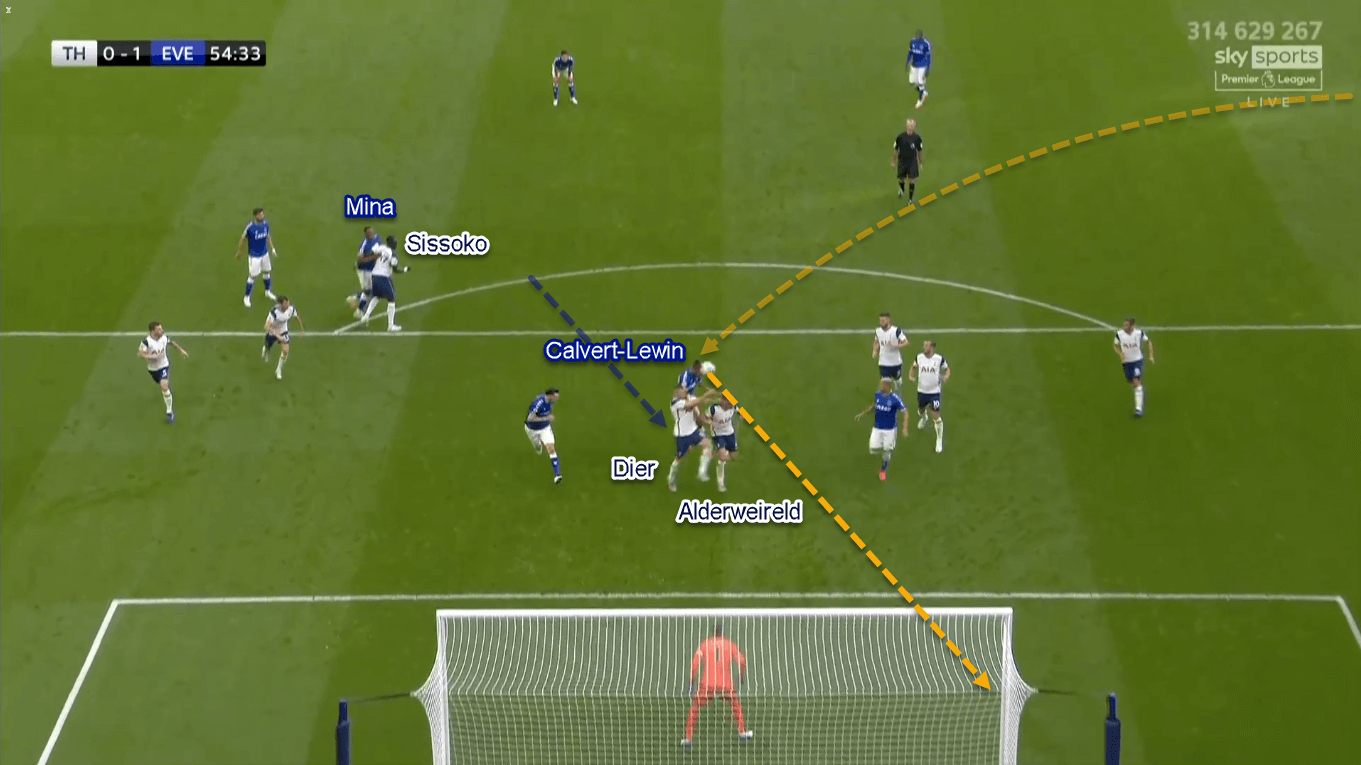
Conclusion
The narrow win for the visitors marked Mourinho’s first-ever opening-day defeat in his managerial career. Some might argue that the officials were the ones to blame for the game’s only goal. But, doing so would not do justice to Ancelotti and his brilliant tactics.
The Italian manager showed his unfathomable experience by adjusting his tactics throughout the game. That being his adaptability to contain Spurs’ counter-attacking threats early in the game to nullify their flank-heavy approach in the last 20 minutes. The similar could be said to Mourinho, too. He also produced some superb in-game managements to counter Ancelotti’s ever-changing strategy from time to time despite having to surrender at the final whistle.
Regardless of the result, this game definitely produced a great tactical battle between two elite-level managers. And the great news is, this is just the beginning. Welcome back, Premier League!





Comments